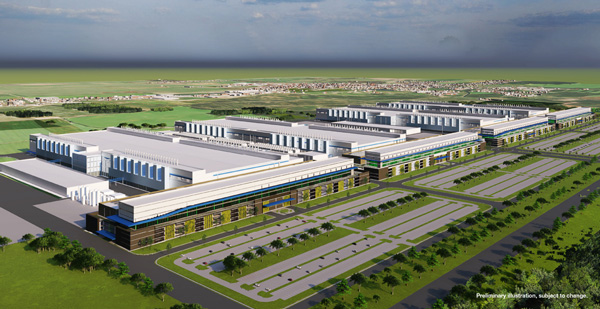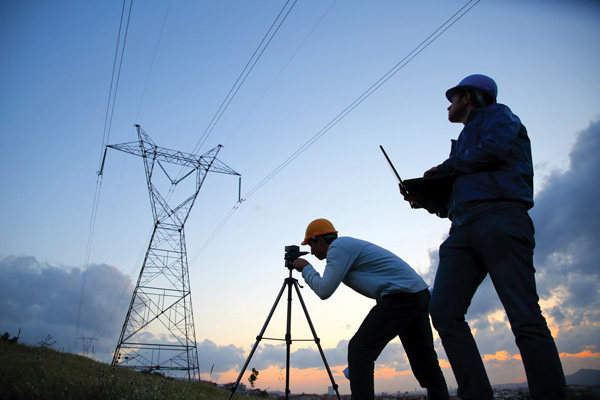Demand for electricity, both commercial and residential, is surging nationwide, even as aging grids show signs of strain. That’s why Upstate Upgrade, a $4 billion investment by the utility National Grid, is one of several potential game changers for Upstate New York and its surging semiconductor sector. The six-year project announced in March is to yield more than 1,000 miles of new transmission lines along with new and upgraded substations across 10 Upstate counties.
The investment, the utility says, is to include new technologies that will increase the grid’s performance and reliability — especially in the face of increasing threats posed by extreme weather — while enabling the delivery of a growing portfolio of renewable energies.
“With the combination of increased demand to power everything from smart devices to heat pumps and everything in between, as with the amounts of renewable energy being produced, the transmission system needs an upgrade,” the first in about a century, explains Jared Paventi, National Grid’s communications manager. “What we’re doing will make the grid smarter, stronger and cleaner.”
Nicholas Bruno, vice president of business development for Mohawk Valley EDGE, a regional economic development organization based in Oneida County, is among those applauding National Grid for its big investment.
“The first question on all the RFIs [Requests for Information] I’m getting nowadays is ‘How much power can you get me?’ ” Bruno tells Site Selection. “Power is the name of the game. So, anytime you’re investing in your power infrastructure, you’re helping to make what you have even better, and now industry is willing to take a look at you.”
Behind the Numbers
A team led by Paul DeCotis, senior partner for energy and utilities at the business consulting firm West Monroe, ran a third-party economic analysis that found that Upstate Upgrade could generate nearly $2 billion in economic output across the state, while creating up to 2,900 long-term jobs — “due to new businesses, expanded energy projects and electrification” — plus another 1,700 jobs during construction.
 Micron’s planned “Megafab” in Upstate New York
Micron’s planned “Megafab” in Upstate New York
Rendering courtesy of Micron
“We actually believe our numbers are conservative,” DeCotis tells Site Selection, “but those numbers really do speak for themselves.”
On a granular level, West Monroe projected economic benefits arising from metrics ranging from hotel and meal spending by workers during construction to downstream gains including increased property values and property tax collections. Of course, for residential customers and businesses alike, it’s always nice when the lights and heat don’t fail.
“New York is taking another major leap toward building Chips Country in our state.”
— Gov. Kathy Hochul
Bigger picture, DeCotis believes the updated grid will prove attractive to heavy users like Micron, whose chip-making “Megafab” north of Syracuse — being built through a projected 20-year investment of $100 billion with estimated job creation of nearly 50,000 — is a venture the likes of which the region has never seen.
“Micron could not locate here if we did not have the significant electricity transmission infrastructure upgrades,” DeCotis says, “because we would not be able to serve their load. It’s infrastructure projects like this that make that economic development opportunity available.”
Bruno tells Site Selection that Upstate Upgrade bolsters the prospects of the Marcy Nanocenter, owned and marketed by EDGE and located on the campus of SUNY Polytechnic
Institute in Utica. Its anchor tenant is Wolfspeed, the North Carolina-based semiconductor manufacturer that’s investing a billion dollars in what is being billed as the world’s first 200-mm silicon carbide fab. Among other partnerships, Wolfspeed has supplier agreements with companies that include General Motors and Lucid Motors to provide silicon carbide semiconductors for electric vehicles.
With close to 130 acres still open to development, EDGE hopes to lure other semiconductor businesses to Marcy. Bruno believes Upstate Upgrade can only help.
“Reliability is the big one here,” he says. “With the billions of dollars they are investing, the semiconductor industry cannot have downtime and does not have tolerance for brownouts, rolling or otherwise. If you have a blip in the system, for these companies you’re talking about millions of dollars of lost revenue. So, reliability is just a huge selling point.”
Emergence of a Hub
As with the Marcy Nanocenter, EDGE hopes to bring semiconductor manufacturing and supply chain projects to its 3,500-acre Griffiss Business and Technology Park, which sits on the grounds of the former Griffiss Air Force Base. The base was stripped of its military mission in 1995 under the Pentagon’s Base Realignment and Closure program. The Griffiss park is currently home to the Air Force Research Laboratory, which develops cutting-edge technologies for military and civilian applications. The park hosts dozens of other tech-focused businesses that employ close to 8,000 workers, Bruno says.
“It’s another awesome testament,” he says, “to what we have going on here.”
“Reliability is a huge selling point..”
— Nicholas Bruno, Mohawk Valley EDGE
In March, Oneida County was awarded $23.6 million from the state’s Focused Attraction of Shovel-Ready Tracts New York (FAST NY) program to develop the park’s 332-acre “Triangle Site” into a semiconductor supply chain campus. Further boosted by a local $2.7 million match, the FAST NY grant is being funneled into electrical upgrades, water and sewer extensions, roads and other site work.
“Conveniently located in the center of New York State and positioned adjacent to Wolfspeed and Micron, Oneida County’s Triangle Site at Griffiss is positioned to be the state’s premier semiconductor supply chain campus, offering up to 50 megawatts of new power,” said County Executive Anthony Picente. “This largest shovel-ready site in the state will unlock up to 2.6 million square feet of new construction and the potential for 3,000 jobs. This is,” Picente said, “a huge opportunity for our community.”
The Hits Keep Coming
Adding to the Upstate’s semiconductor buildout, a $10 billion public-private partnership that includes Micron, IBM, Applied Materials and Tokyo Electron is funding a semiconductor research center at the Albany NanoTech Complex. Established in 1997 and measuring 1.65 million sq. ft., Albany NanoTech is touted as the country’s largest and most advanced non-profit semiconductor R&D facility. The cornerstone of the project, announced in December, will be the acquisition and installation of a High Numerical Aperture (High NA) Extreme Ultraviolet (EUV) lithography tool, a Dutch-made instrument that allows for dramatically improved resolution in chip manufacturing, thus enabling the creation of smaller transistors and features on semiconductor chips.
“The new High NA EUV Center at Albany NanoTech will secure a strong pipeline for semiconductor innovation, keeping New York State at the center of semiconductor expertise,” said IBM Chairman and CEO Arvind Krishna in a statement. Micron President and CEO Sanjay Mehrotra added that the project “is a critical step in advancing next-generation semiconductor R&D in America and will put New York at the forefront of future innovation and technology leadership.”
The massive investment, which includes $1 billion from the state, is seen as having been instrumental to the acquisition of “Phase 2” implementation funding under the Biden Administration’s Tech Hubs program for the New York Semiconductor Manufacturing and Research Technology Innovation Corridor (NY SMART-I) consortium. NY SMART-I won a $40 million federal grant, one of 13 nationwide hubs to receive Tech Hub funding announced July 2.
“With this transformative federal grant, New York is taking another major leap toward building Chips Country in our state,” said Gov. Kathy Hochul.
The Tech Hub consortium comprises the Western New York, Finger Lakes and Central New York regions. It is led by the Buffalo-Niagara Partnership, ROC2025 and CenterState CEO and includes more than 80 members, including economic development organizations, governments, workforce development groups, labor, industry and academia.

